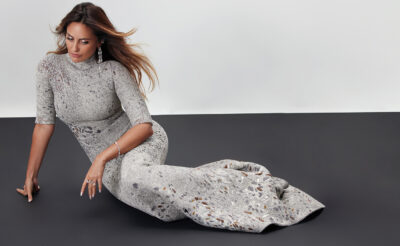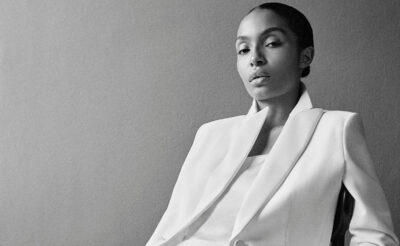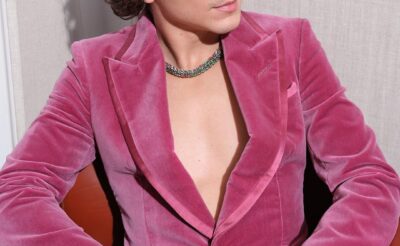British fashion designer Antonio Berardi is the King of the cocktail dress, revered for his slim fitting, avant-garde gowns. We meet him in Abu Dhabi to delve into his creative inspirations and marvel at his understanding of a woman’s shape
These are fashion designs that one would not wear every day, making them more akin to objets d'art than mere style statements.
Over the years, the designer has received much acclaim for his figure-hugging gowns, at once classic, elegant whilst giving just a hint of the avant-garde. Pushing the boundaries of design while also adhering to the classical canon of women’s fashion is something Berardi has excelled at. Examples of dresses that have embodied the interesting crossover between the worlds of fashion and Contemporary include the illuminated coat he designed with light bulbs that lit up to form a crucifix for his autumn/ winter 2003 collection in Milan. There was also the trompe-l’oeil corset dress in black and white with lace detailing. These are fashion designs that one would not wear every day, making them more akin to objets d’art than mere style statements. Even so, they worked with the collection they were part of.
‘The illuminated pieces were from a collection that took its inspiration from Punk and the Borgias – a collection that was religious and anarchical at the same time,’ he explains. ‘The Gwyneth dress was from a collection inspired by Sicily. It was based on the idea that underpinnings are just as important as the clothes you wear on top of them, so why not show just how beautiful they are?’
What lies underneath – the true essence of a woman – is the inherent meaning behind Berardi’s fashion designs. In November, the designer showed his work at a private show in Abu Dhabi during the weekend of the Coutts Polo at the Emirates Palace. He adjusted his designs specifically to suit the Middle Eastern woman. ‘We stripped things back, and took out the daywear, which I thought was less relevant for the market,’ he says. ‘What I loved is that those present appreciated the detail and the 360 degree elements of the clothing. The Middle East has a very aware, fashion forward crowd.’ Berardi has found the Middle Eastern market to be very much about individualism and attention to detail; ‘My work is about exalting women, while always being respectful of modesty and cultural norms. I am always striving to bring out the personality of the wearer through unique pieces with great attention to detail.’ The Middle Eastern market could certainly benefit from Berardi’s one-off, special pieces created for the women of the region.
The designer likes to be constantly challenged, and contemporary art does exactly this. Berardi’s fashion designs are enhanced by the lines, attitude and timeless appeal that can also be found in fine art. ‘I like to be challenged, consciously and sub-consciously,’ he says. ‘I love the Chapman brothers, who are friends, Rachel Kneebone, and Oscar Niemeyer because he is always modern.’
Berardi has designed clothes for some of the world’s most famous women including Angelina Jolie, Victoria Beckham and Sarah Jessica Parker. But strip away all of the success and beauty that Berardi’s fashion designs have garnered and it comes down the art of form and the exaltation of beauty. Sicily, the artist’s native country, still remains close to his heart. ‘The craftsmanship, the femininity and the pride that is omnipresent on the island has played a great part in my work,’ he says. ‘I grew up with aunts and my grandmother embroidering and making bobbin-lace, and a mother who taught us how to love and appreciate beautiful things.’ And so he’s continued the Italian tradition of honoring beauty in his own way. Designing is about pleasing people. As he says, ‘It’s about making sure you’re giving people what they want, something beautiful and classic, more than the commercial aspect.’ And that he has done.
Sheer-paneled with kimono sleeves, peplum detail and colour blocking, Antonio Berardi’s optical illusion gown was worn by Gwyneth Paltrow to the Iron Man 3 premiere in Hollywood earlier last year – a showstopper in itself with its combination of sheer panels running teasingly up each side, covering the body while exposing it ever so slightly. The next day, magazines everywhere showcased the look and Berardi’s phone rang non-stop with praise. As is customary in the designer’s pedigree, the gown emphasized not only Berardi’s artful lines, but the grace and character of the wearer. Paltrow radiated confidence and beauty, with the dress showing off the curves of her body from every aspect. ‘I like to give a dress a 360 degree treatment so that it looks great from every angle,’ says Berardi. ‘It’s about the wearer ‘s overall figure as well as her persona.’ This complete dedication to the art of form and the character behind a dress is what has propelled Berardi to his current fame.
It all began when he was very young, growing up with three sisters and a very particular mother who was always keen to find the right outfit for each occasion. ‘I became enraptured by the ceremony of dressing,’ says Berardi. ‘The dress always needed to be just right.’ He tells how he used to sneak into his parents’ room and ruffle through his mother’s clothes. There he’d sift through drawers of handkerchiefs each dedicated to a certain colour, and imagine the interesting outfits that he could make.
As Sicilians who had immigrated to the UK in the 1950s, Berardi’s parents didn’t have a lot of money. ‘Growing up, fashion was about making something beautiful out of something ordinary,’ he says. He cites examples of embroidering his sister’s plain nightgowns and how his mother and his sisters would often pass around a garment each using one of their specialties to sew and embroider it to make it unique.
Berardi became captivated by fashion. As a nine year old, the designer would often save his money for Armani shirts with leather gusset shoulders in order to wear the ‘in’ look of the time. ‘Fashion was something I always wanted to do,’ says Berardi. ‘The way we dressed was always of utmost importance to my parents, good Sicilian immigrants, and I guess it was something that was instilled in me from an early age. I had the choice of studying medicine, law or fashion, so of course I went for the most interesting.’
After high school Berardi decided on a career in design, but after attending Lincoln College of Art and Design, he applied for a Bachelor’s degree in fashion from Central Saint Martin’s College of Art and Design. His application was rejected and instead he began working as an assistant with John Galliano. But the desire to obtain a degree in fashion stuck with him, and after applying for a third time in 1990, he was accepted. He graduated in 1993 and in 1994 his graduate collection caught the eye of Angela Quaintrell, a buyer for London fashion holding group Liberty. In 1995, he produced his first fashion week collection under his eponymous label with financial backing from the group. A success, the show’s main model was Kylie Minogue and the accessories were designed by Manolo Blahnik and Philip Treacy.



